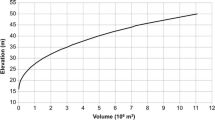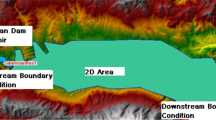Abstract
Dams are important structures having many functions such as water supply, flood control, hydroelectric power and recreation. Although dam break failures are very rare events, dams can fail with little warning and the damage at the downstream of the dam due to the flood wave can be catastrophic. During a dam failure, immense volume of water is mobilized at very high speed in a very short time. The momentum of the flood wave can turn to a very destructive impact force in residential areas. Therefore, from risk point of view, understanding the consequences of a possible dam failure is critically important. This study deals with the methodology utilized for predicting the flood wave occurring after the dam break and analyses the propagation of the flood wave downstream of the dam. The methodology used in this study includes creation of bathymetric, DEM and land use maps; routing of the flood wave along the valley using a 1D model; and two dimensional numerical modeling of the propagation and spreading of flood wave for various dam breaching scenarios in two different urban areas. Such a methodology is a vital tool for decision-making process since it takes into account the spatial heterogeneity of the basin parameters to predict flood wave propagation downstream of the dam. Proposed methodology is applied to two dams; Porsuk Dam located in Eskişehir and Alibey Dam located in Istanbul, Turkey. Both dams are selected based on the fact that they have dense residential areas downstream and such a failure would be disastrous in both cases. Model simulations based on three different dam breaching scenarios showed that maximum flow depth can reach to 5 m at the border of the residential areas both in Eskişehir and in Istanbul with a maximum flow velocity of 5 m/s and flood waves having 0.3 m height reach to the boundary of the residential area within 1 to 2 h. Flooded area in Eskişehir was estimated as 127 km2, whereas in Istanbul this area was 8.4 km2 in total.



















Similar content being viewed by others
References
Alcrudo F, Mulet J (2007) Description of the Tous Dam break case study (Spain). J Hydraulic Res 45:45–58
Altinakar (2008) Report by working group on dam issues related to floodplain management submitted to association of state flood plain managers
Bates PD, de Roo APJ (2000) A simple raster-based model for flood inundation simulation. J Hydrol 236(1):54–77
Bellos V, Tsakiris G (2015) Comparing various methods of building representation for 2D flood modelling in built-up areas. Water Resour Manag 29(2):379–397
Bozkus Z, Bag F (2011) Virtual failure analysis of Çınarcık Dam. TeknikDergi 22(4):5675–5688 (in Turkish)
Bozkus Z, Guner AI (2001) Pre-event dam failure analyses for emergence management. Turkish J Eng Environ 25:627–641
Brufau P, Vazquez-Cendon ME, Garcia-Navarro P (2002) A numerical model forflooding and drying of irregular domains. Int J Numerical Methods Fluids 39:247–75
Chen SA, Evans B, Djordjevic S, Savic DA (2012a) A coarse-grid approach to representing building blockage effects in 2D urban flood modeling. J Hydrol 426–427:1–16
Chen SA, Evans B, Djordjevic S, Savic DA (2012b) Multi-layered coarse grid modelling in 2D urban flood simulations. J Hydrol 470–471:111
Costa JE (1985) Floods from dam failures. U.S. Geological Survey, Open-File Rep. No. 85–560, Denver, 54
Dottori F, Todini E (2013) Testing a simple 2D hydraulic model in an urban flood experiment. Hydrol Process 27(9):1301–1320
FLO-2D Software Inc (2009) FLO-2D users manual. Documentation. Retrieved from http://www.flo-2d.com/
FLO-2D Software Inc (2009) FLO-2D reference manual. Documentation. Retrieved from http://www.flo-2d.com/
Froehlich DC (2008) Embankment dam breach parameters and their uncertainties. J Hydraulic Eng 134(12):1708–1721
Guney MS, Tayfur G, Bombar G, Elci S (2014) Distorted physical model to study sudden partial Dam break flows in an Urban area. J Hydraulic Eng 140:11
Haltas I, Tayfur G, Elci S (2016) Two-dimensional numerical modeling of flood wave propagation in an Urban area due to Ürkmez Dam-Break, İzmir, Turkey. Nat Hazards 81:2103–2119
Macchione F (2008) Model for predicting floods due to earthen dam breaching. I. Formulation and evaluation. J Hydraulic Eng 134(12):1688–1696
Mahdizadeh H, Stansby PK, Rogers BD (2012) Flood wave modeling based on a two-dimensional modified wave propagation algorithm coupled to a full-pipe network solver. J Hydraul Eng 138(3):247–259
Moramarco T, Barbetta S, Pandolfo C, Tarpanelli A, Berni N, Morbidelli R (2013) The spillway collapse of the Montedogliodamon the Tiber River (central Italy): data collection and event analysis. J Hydrologic Eng
NOAA (2000) National weather service’s FLDWAV computer program
Petaccia G, Natale L (2008) Simulation of the Sella Zerbino Catasrophic Dam Break. In Altinakar K, Aydın Ç, Kırkgöz (Eds) Riverflow 2008, 1, 601–607, Kubaba
Pilotti M, Maranzoni A, Tomirotti M, Valerio G (2011) 1923 Gleno Dam break: case study and numerical modeling. J Hydraulic Eng 137(4):480–492
Qi H, Altinakar M (2012) GIS-based decision support system for Dam break flood management under uncertainty with two-dimensional numerical simulations. J Water Resour Plann Manage 138(4):334–341
Samuels PG (1989) Backwater lengths in rivers. Proc Inst Civil Eng, Part 2, Res Theory 87:571–582
Schubert EJ, Sanders FB (2012) Building treatments for urban flood inundation models and implications for predictive skill and modelling efficiency. Adv Water Resour 41:49–64
Singh J, Altinakar MS, Ding Y (2011) Two-dimensional numerical modeling of dam-break flows over natural terrainusing a central explicit scheme. Adv Water Resour 34:1366–1375
Tsakiris G, Bellos V (2014) A numerical model for two-dimensional flood routing in complex terrains. Water Resour Manag 28:1277–1291. doi:10.1007/s11269-014-0540-3
USACE HEC-RAS (2012) Documentation. Retrieved from http://www.hec.usace.army.mil/software/hec-ras/
USACE (2014) Using HEC-RAS for dam-break studies. Report No: TD-39, USACE
Yanmaz AM, Seçkiner G, Ozaydın V (2001) A method for optimum layout design of concrete gravity Dams. Water Eng Res, Int J Korea Water Resources Assoc 2(4):199–207
Ying X (2005) CCHE2D-DAMBREAK model version 1.0, user’s guide, NCCHE, the University of Mississippi
Acknowledgments
This study was funded by research grant from the Turkish Science Foundation (TÜBITAK) through Project No: 110 M240. We thank TÜBİTAK for this support. We thank BülentKocaman at Turgut Özal University, Civil Engineering Department for producing some of the flood maps.
Author information
Authors and Affiliations
Corresponding author
Rights and permissions
About this article
Cite this article
Haltas, I., Elçi, S. & Tayfur, G. Numerical Simulation of Flood Wave Propagation in Two-Dimensions in Densely Populated Urban Areas due to Dam Break. Water Resour Manage 30, 5699–5721 (2016). https://doi.org/10.1007/s11269-016-1344-4
Received:
Accepted:
Published:
Issue Date:
DOI: https://doi.org/10.1007/s11269-016-1344-4




